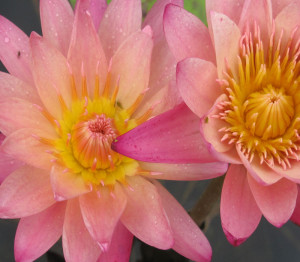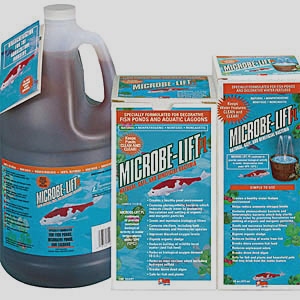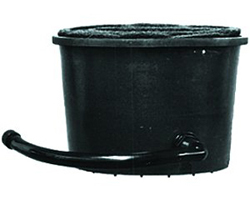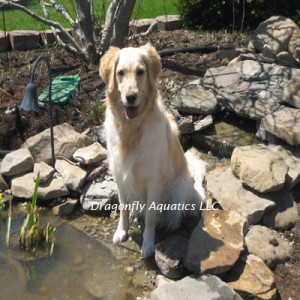 Its officially fall now and we need to begin preparing our pond for the winter and hopefully a cleaner pond for spring. I've listed a few maintenance tips to guide you through preparing your pond for the winter. I still have a few flowers appearing in my pond but I think they are almost through blooming for the season 🙁
Its officially fall now and we need to begin preparing our pond for the winter and hopefully a cleaner pond for spring. I've listed a few maintenance tips to guide you through preparing your pond for the winter. I still have a few flowers appearing in my pond but I think they are almost through blooming for the season 🙁
FALL/WINTER POND MAINTENANCE TIPS
1. Before winter arrives, you will want to make sure your pond and filtering system are clean to ensure good water quality throughout the winter months. With the arrival of fall it is wise to do a partial water change to remove any built up contaminants to improve water quality. Partial water changes need to be made before water temperatures fall below 60 degrees to minimize fish stress. Adding pond salt at this time will improve the slime coating of fish, to help them ward off disease and parasites.
2. Before the leaves begin to fall, cover your pond with one of ourpond nets. The goal is to try and keep the pond as clean as possible for the winter months. Leaves will sink to the bottom of the pond and rot, causing excess carbon dioxide and hydrogen sulfide. After the first frost, take out any floating plants, as these will begin to decay. Trim back hardy lilies and bog plants and place below the freeze line.
3. Switch to Microbe-Lift Autumn/Winter Prep. This will help break down organic material in the pond before winter sets in. Microbe-Lift Autumn/Winter Prep helps accelerate the decomposition of leaves, scum, sediment and other organic matter during the fall and throughout the winter months. Also, Microbe-Lift Autumn/Winter Prep helps to maintain a healthy immune system for your fish during the winter months. Microbe-Lift Autumn/Winter Prep will help jump-start your pond to a healthier environment in the spring.
4.Reduce your fish feeding as the water temperatures drop below 60 degrees. Start feeding your fish a couple of times a week. We recommend switching to a wheat germ based fish food formulated for fall and spring feeding. When water temperatures drop below 60 degrees, the metabolism of your fish slow down. Both Tetra-Pond Spring/Fall and Microbe-Lift Cold Weather fish food are highly digestible cool weather diets that are made with less protein, but contain wheat germ, which is easily digested. They also contain higher levels of fat, which help your fish survive their winter hibernation. When water temperatures reach 50 degrees, stop feeding your fish completely. Feeding at water temperatures below 50 degrees can possibly kill your fish. A pond thermometeris a must have. This will help you in determining when to stop feeding your fish and will also help to know when to begin feeding your fish in the spring. Its also a good idea to know your water temperature for those adding tropical pond plants to your pond in the spring.
5.Adding Microbe-Lift Barley Straw Extract will help control string algae throughout the fall and winter months. Barley Straw Extract is an effective and eco-friendly way to reduce algae. Unlike algaecides, which are ineffective in water temperatures below 50 degrees, Microbe-Lift Barley Straw Extract will continue to control algae throughout the winter months.
6.Before freezing temperatures begin, install a pond de-icer. Ponds covered with ice do not allow toxic gases to escape causing fish loss. A pond de-icer will keep a section of your pond open to allow oxygen and gas exchange.
7.During the winter removing snow from the surface of the pond will help submerged plants and microscopic aquatic plants to continue to produce oxygen as long as light penetrates through the ice. Insufficient light, along with the decomposition of plant and leaf debris may result in insufficient oxygen for the fish, causing them to suffocate. Removing the snow from a portion of your surface area will reduce the likelihood of this occurring.
Remember to add a tray of sand in your pond for the frogs to have a place to winter over.
With spring upon us its important to check on your fish. Its a critical time for them when they start coming out of dormancy. They are more likely to become vulnerable to illness unless proper steps are taken. When coming out of dormancy their bodies are low on the important nutrients needed to help ward of diseases.
First make sure you clean your pond out of all debris and sludge at the bottom. Microbe-Lift makes a good product called Sludge Away which can help. You can at this time replace about 30% of your pond water. If using tap water make sure you add a water conditioner to remove heavy metals, chlorine, and chloramines found in most tap water. If using tap water that goes through a softener this adds salt and its not necessary to add a water conditioner.
Its important to maintain a healthly ecosystem throughout the pond season. This will help maintain healthly fish and keep your pond clear and free of algae. Add a good beneficial bacteria, such as Microbe-Lift PL to your pond water regularly. Its amazing how this can help you keep your pond balanced.
Official its Fall now.....the other day it was 88 degrees out....today its 52 degrees and looks like fall. Chill in the air, cloudy skies and rain off and on. I still need a few more nice warm days before settling in for the dreaded winter months. I still have to prepare my pond for winter....I always seem to let it go until the last minute. Hopefully I get those few more warm days or I'll be sorry.
I decided to share some preparation tasks for your pond before the weather changes and we all settle in for the winter. This will help improve your pond water and hopefully help make the spring clean up less work.
FALL/WINTER POND MAINTENANCE TIPS
1. Before winter arrives, you will want to make sure your pond and filtering system are clean to ensure good water quality throughout the winter months. With the arrival of fall it is wise to do a partial water change to remove any built up contaminants to improve water quality. Partial water changes need to be made before water temperatures fall below 60 degrees to minimize fish stress. Adding pond salt at this time will improve the slime coating of fish, to help them ward off disease and parasites.
2. Before the leaves begin to fall, cover your pond with one of our pond nets. The goal is to try and keep the pond as clean as possible for the winter months. Leaves will sink to the bottom of the pond and rot, causing excess carbon dioxide and hydrogen sulfide. After the first frost, take out any floating plants, as these will begin to decay. Trim back hardy lilies and bog plants and place below the freeze line.
3. Switch to Microbe-Lift Autumn/Winter Prep. This will help break down organic material in the pond before winter sets in. Microbe-Lift Autumn/Winter Prep helps accelerate the decomposition of leaves, scum, sediment and other organic matter during the fall and throughout the winter months. Also, Microbe-Lift Autumn/Winter Prep helps to maintain a healthy immune system for your fish during the winter months. Microbe-Lift Autumn/Winter Prep will help jump-start your pond to a healthier environment in the spring.
4.Reduce your fish feeding as the water temperatures drop below 60 degrees. Start feeding your fish a couple of times a week. We recommend switching to a wheat germ based fish food formulated for fall and spring feeding. When water temperatures drop below 60 degrees, the metabolism of your fish slow down. Both Tetra-Pond Spring/Fall and Microbe-Lift Cold Weather fish food are highly digestible cool weather diets that are made with less protein, but contain wheat germ, which is easily digested. They also contain higher levels of fat, which help your fish survive their winter hibernation. When water temperatures reach 50 degrees, stop feeding your fish completely. Feeding at water temperatures below 50 degrees can possibly kill your fish. A pond thermometer is a must have. This will help you in determining when to stop feeding your fish and will also help to know when to begin feeding your fish in the spring. Its also a good idea to know your water temperature for those adding tropical pond plants to your pond in the spring.
5.Adding Microbe-Lift Barley Straw Extract will help control string algae throughout the fall and winter months. Barley Straw Extract is an effective and eco-friendly way to reduce algae. Unlike algaecides, which are ineffective in water temperatures below 50 degrees, Microbe-Lift Barley Straw Extract will continue to control algae throughout the winter months.
6.Before freezing temperatures begin, install a pond de-icer. Ponds covered with ice do not allow toxic gases to escape causing fish loss. A pond de-icer will keep a section of your pond open to allow oxygen and gas exchange.
7.During the winter removing snow from the surface of the pond will help submerged plants and microscopic aquatic plants to continue to produce oxygen as long as light penetrates through the ice. Insufficient light, along with the decomposition of plant and leaf debris may result in insufficient oxygen for the fish, causing them to suffocate. Removing the snow from a portion of your surface area will reduce the likelihood of this occurring.
 Microbe-Lift PL is the product most often used to maintain the natural biological and chemical balance of your pond in all seasons. We've talked about the Spring/Summer Cleaner which works wonders in accelerating the breakdown of leaves, twigs and other accumulated dead organic waste. The Microbe-Lift PL is formulated for decorative ponds and is easy to use.
Microbe-Lift PL is the product most often used to maintain the natural biological and chemical balance of your pond in all seasons. We've talked about the Spring/Summer Cleaner which works wonders in accelerating the breakdown of leaves, twigs and other accumulated dead organic waste. The Microbe-Lift PL is formulated for decorative ponds and is easy to use.
MicrobeLift PL creates a cleaner environment for your pond, promoting faster fish growth and reduces ammonia nitrogen levels. It helps dissolve away organic sludge and seeds and maintains biological filters. It reduces buildup of bird droppings, fish feed and dead leaves and will also break down dead algae. Reduces hydrogen sulfide, which creates strong, offensive odors. Improves dissolved oxygen levels and is effective over a wide range of pH conditions.
Its application depends on the size of water feature/pond you have. Shake the bottle well before using and add the amount of product indicated on the container for the size of pond you have. You can spread it around the edges of your pond or apply in one location. It will become distributed more quickly in a larger pond if applied in different areas.
The application rates depend on the size of pond you have. The recommendations are as follows:
SIZE OF POND/ 1ST APPLIC. NEXT 4 WKS MAINTENANCE
WATER FEATURE (ONCE WKLY) (ONCE MONTHLY)
IN GALLONS
50 - 200 8 oz 2 oz 2 oz
201-500 10 oz 3 oz 3 oz
501-1,000 12 oz 4 oz 4 oz
1,000-5,000 16 oz 6 oz 6 oz
5,001-10,000 18 oz 8 oz 8 oz
You can store Microbe-Lift PL for approximately 2 years if unopened and for 1 year if opened and store in a dark cool area.
By establishing and maintaining a healthy balance in the pond, and by removing organic waste matter, your water will obtain clarity.
 We've covered water temperatures, so what else should we do early spring prior to adding pond plants? We would like to mention a few things you should check when opening your pond for the season.
We've covered water temperatures, so what else should we do early spring prior to adding pond plants? We would like to mention a few things you should check when opening your pond for the season.
Check your pond to make sure there are no tears or leaks in your pond liner. Check around the edges of your pond to make certain the ground has not settled, and your pond is not leaking around the perimeter. Check out all your tubing, connections, pond pumps and filters to make sure they are all secure and working properly. If you have left your pump run throughout the winter make sure it is working properly. And for those who have turned off their pumps, you should check and clean them thoroughly. Turn your pump back on once the water temperatures are consistently above freezing which is around 40-45 degrees.
Remove any debris that has accumulated in your pond during the fall and winter. For those of you that have a pond vac, now is the best time to use those to rid your pond of small unwanted particles. You can begin putting MicrobeLift Spring and Summer in your pond to help with the cleanup. MicrobeLift Spring and Summer contains cold weather bacteria cultures that will work in the cooler water temperatures of spring. This will start establishing good bacteria and help accelerate the break down of debris. The spring rains help to flush your ponds, so if possible drain some of the water out of your pond and let the rain rinse and fill it up.
Once everything has been checked out you can begin thinking about feeding your fish, if you have them, and dividing some of the pond plants that have out grown their planting containers. We will discuss this in our next addition to Here Comes Spring.
 Time to spring forward, or at least turn the clocks forward! Things are beginning to warm up a bit here in the north and we are anxiously waiting for Spring to arrive so we can begin to add new plants to our ponds. Another couple of months and we will be sitting back enjoying our ponds once again. It won't be long now. For those in the warmer regions, zones 8 and above, you are putting pond plants in your ponds and starting to enjoy them, while those of us in the lower zones are still waiting. At least most of the ice has melted and we can begin thinking about our ponds once again.
Time to spring forward, or at least turn the clocks forward! Things are beginning to warm up a bit here in the north and we are anxiously waiting for Spring to arrive so we can begin to add new plants to our ponds. Another couple of months and we will be sitting back enjoying our ponds once again. It won't be long now. For those in the warmer regions, zones 8 and above, you are putting pond plants in your ponds and starting to enjoy them, while those of us in the lower zones are still waiting. At least most of the ice has melted and we can begin thinking about our ponds once again.
Don't be fooled by Mother Nature. We need to make sure it is warm enough outside, and make sure our pond water is warm enough for the plants to survive. Knowing your pond temperature is crucial, so begin by checking your pond water temperature at different times of the day. The pond water is cooler in the morning and warmer in the afternoon but will cool down again in the evening. Knowing what the consistant temperature of your pond water is important before adding the pond plants.
The first plants most of us want to put in are those that will help us keep the pond clear, such as floating plants like water hyacinths and water lettuce. Cold water will kill both of these in a matter of days if the water temperature is still too cold. We need to make sure the water temperature is consistent and reaches 65 degrees and stays there morning, afternoon and evening before we add floating plants.
There are other things we must do first that will keep us busy, such as adding beneficial bacteria to help keep our pond clear. The good bacteria, such as MicrobeLift PL neutralizes ammonia and nitrites, and will start to work when the water temperature are 50-55 degrees. If you add bacteria, it will stay in the pond and start working when the pond water is warm enough. It acts on its own and will stay un-activated until it knows to start working. For those of us who use barley, now is the right time to start adding it. This will also help retard the growth of string algae in the Spring months.
The list goes on and on. While all of us are anxious to add the pond plants there are still several things to do prior to this. I will be posting articles in the next few days with spring tips for our ponds.
Stay tuned!